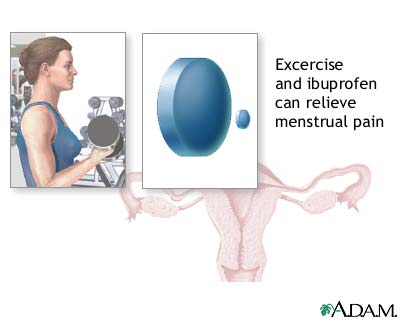Health Library
Premenstrual syndrome - self-care
PMS - self-care; Premenstrual dysphoric disorder - self-care
Images

I Would Like to Learn About:
Description
Premenstrual syndrome, or PMS, refers to a set of symptoms that most often:
- Start during the second half of a woman's menstrual cycle (14 or more days after the first day of your last menstrual period)
- Go away within 1 to 2 days after your menstrual period starts
Keep a Diary of Symptoms
Keeping a calendar or diary of your symptoms can help you identify the symptoms that are causing you the most trouble. Writing down your symptoms on a calendar can help you understand possible triggers for your symptoms. It can also help your health care provider choose an approach that is most helpful for you. In your diary or calendar, be sure to record:
- The type of symptoms you are having
- How severe your symptoms are
- How long your symptoms last
- Whether your symptoms respond to a treatment you tried
- At what point during your cycle your symptoms occur
You may need to try different things to treat PMS. Some things you try may work, and others may not. Keeping track of your symptoms may help you find the treatments that work best for you.
Healthy Lifestyle Changes
A healthy lifestyle is the first step to managing PMS. For many women, lifestyle changes alone are enough to control their symptoms.
Changes in what you drink or eat may help. During the second half of your cycle:
- Eat a balanced diet that includes lots of whole grains, vegetables, and fruit. Have little or no salt or sugar.
- Drink plenty of fluids like water or juice. Avoid soft drinks, alcohol, or anything with caffeine in it.
- Eat frequent, small meals or snacks instead of 3 large meals. Have something to eat at least every 3 hours. But do not overeat.
Getting regular exercise throughout the month can help reduce how severe your PMS symptoms are.
Medicines, Vitamins, Supplements
Your provider may recommend that you take vitamins or supplements.
- Vitamin B6, calcium, and magnesium may be recommended.
- Tryptophan supplements may also be helpful. Eating foods that contain tryptophan may also help. Some of these are dairy products, soy beans, seeds, tuna, and shellfish.
Pain relievers, such as aspirin, ibuprofen (Advil, Motrin, and others), naproxen (Naprosyn, Aleve), and other medicines may help symptoms of headache, backache, menstrual cramping, and breast tenderness.
- Tell your provider if you are taking these medicines most days.
- Your provider may prescribe stronger pain medicines for severe cramping.
Your provider may prescribe birth control pills, water pills (diuretics), or other medicines to treat symptoms.
- Follow the directions for taking them.
- Ask about possible side effects and tell your provider if you have any of them.
If you are Feeling Sad or Stressed
For some women, PMS affects their mood and sleep patterns.
- Try to get plenty of sleep throughout the month.
- Try changing your nighttime sleep habits before you take drugs to help you sleep. For example, do quiet activities or listen to soothing music before going to sleep.
To relieve anxiety and stress, try:
- Deep breathing or muscle relaxation exercises
- Yoga or other exercise
- Massage
Ask your provider about medicines or talk therapy if your symptoms become worse.
When to Call the Doctor
Contact your provider if:
- Your PMS does not go away with self-treatment.
- You have new, unusual, or changing lumps in your breast tissue.
- You have discharge from your nipple.
- You have symptoms of depression, such as feeling very sad, being easily frustrated, losing or gaining weight, sleep problems, and fatigue.
References
Akopians AL. Premenstrual syndrome and dysmenorrhea. In: Mularz A, Dalati S, Pedigo R, eds. Ob/Gyn Secrets. 4th ed. Philadelphia, PA: Elsevier; 2017:chap 2.
Katzinger J, Hudson T. Premenstrual syndrome. In: Pizzorno JE, Murray MT, eds. Textbook of Natural Medicine. 5th ed. Philadelphia, PA: Elsevier; 2021:chap 212.
Mendiratta V, Lentz GM. Primary and secondary dysmenorrhea, premenstrual syndrome, and premenstrual dysphoric disorder: etiology, diagnosis, management. In: Gershenson DM, Lentz GM, Valea FA, Lobo RA, eds. Comprehensive Gynecology. 8th ed. Philadelphia, PA: Elsevier; 2022:chap 35.
BACK TO TOPReview Date: 5/14/2024
Reviewed By: John D. Jacobson, MD, Professor Emeritus, Department of Obstetrics and Gynecology, Loma Linda University School of Medicine, Loma Linda, CA. Also reviewed by David C. Dugdale, MD, Medical Director, Brenda Conaway, Editorial Director, and the A.D.A.M. Editorial team.
 | A.D.A.M., Inc. is accredited by URAC, for Health Content Provider (www.urac.org). URAC's accreditation program is an independent audit to verify that A.D.A.M. follows rigorous standards of quality and accountability. A.D.A.M. is among the first to achieve this important distinction for online health information and services. Learn more about A.D.A.M.'s editorial policy, editorial process and privacy policy. A.D.A.M. is also a founding member of Hi-Ethics. This site complies with the HONcode standard for trustworthy health information: verify here. |
The information provided herein should not be used during any medical emergency or for the diagnosis or treatment of any medical condition. A licensed medical professional should be consulted for diagnosis and treatment of any and all medical conditions. Links to other sites are provided for information only -- they do not constitute endorsements of those other sites. No warranty of any kind, either expressed or implied, is made as to the accuracy, reliability, timeliness, or correctness of any translations made by a third-party service of the information provided herein into any other language. © 1997- 2024 A.D.A.M., a business unit of Ebix, Inc. Any duplication or distribution of the information contained herein is strictly prohibited.
